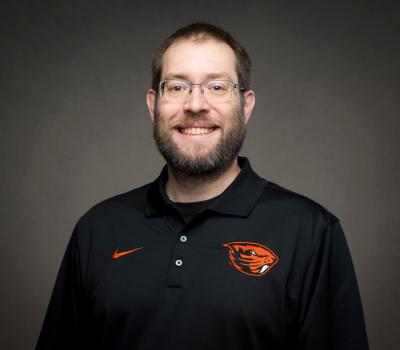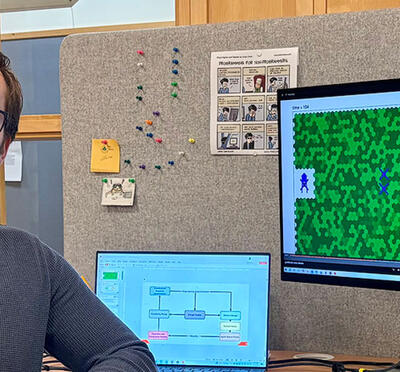The impact of the coronavirus pandemic hit Oregon State University in mid-March, near the end of the winter term. Faculty members scrambled to deliver final exams remotely as social distancing protocols were implemented.
Then the university announced that remote instruction would be required for all courses throughout the spring term, possibly longer. With classes adjourned for “spring break” — the mother of all misnomers for anyone teaching this term — instructional faculty and staff had just over a week to move their entire classroom-based curriculum into the virtual sphere.
In the School of Chemical, Biological, and Environmental Engineering, network administrator Jordan Jones sprang into action to ensure instructors would have the technology, training, and support they needed to conduct classes from home, including suddenly scarce hardware — like webcams, headsets, various laptop adapters, document cameras, and tablets.
“In many cases, trying to find items in stock that would arrive in time was difficult,” Jones said. “In the two weeks leading up to spring term, many on the College of Engineering IT team were putting in extra hours.”
Those extra hours were a boon to faculty, says Milo Koretsky, professor of chemical engineering.
“The technology I needed just kind of showed up as I found out I needed it,” Koretsky said. “So, there was some planning and foresight, and some smart guesswork, in making it available. When I was thinking about things like, ‘How do I give a fair final to my students?’ in winter term, someone else was thinking about the technology for spring already.”
Mere Days to Prepare
Technological hurdles were just one consideration weighing on the minds of CBEE’s teaching professionals, faced with the challenge of redesigning courses for remote delivery in mere days. A typical online course can take weeks or even months to design from scratch, and it can take multiple iterations over successive academic terms to work out all the kinks.
So, faculty members held lots of virtual meetings and informal workshops, using digital video teleconferencing tools like Zoom. They created channels for sharing tips, creative ideas, best practices, and new instructional models using Slack, the digital teamworking platform. In figuring out how to teach remotely, many were also learning how to use these tools themselves for the first time. Their own anxieties and uncertainty offered a preview of what students might have to contend with a week later.
“You have to be cognizant that when something doesn’t work for somebody, and there is a stake in it for them, there understandably becomes a sense of injustice,” Koretsky said. “And when justice is at stake, we as humans tend to have an urgency.”
Professors and instructors would need to adapt to the changing needs of a diverse, dispersed student body. Lectures would be recorded and made available for students to view asynchronously. Course materials would be presented in a variety of formats, and professors would open up new channels for communicating with students.
“One philosophy we had was the idea of redundancy,” Koretsky said. “So, we are accounting for the fact that different people access information in different ways and trying to have it available for them.”
Koretsky teaches a sophomore-level process data analysis class, with over 200 students attending a two-hour lecture twice a week as well as one of nine smaller, two-hour studio sessions with about 24 students each. In studio, students work through authentic engineering problems together.
These studio problems are designed to stretch students’ abilities. Rather than following a determined set of steps to arrive at the right answer, students grapple with “ill-structured, messy, ambiguous, uncertain engineering work.” When people are faced with uncertainty, other humans become important resources, Koretsky says. This promotes teamwork and inclusion of all students. But adapting this type of collaborative learning to the rigors of social distancing has produced some uncertainty of its own.
“Over multiple years, we kind of dialed in how to do this in ways where students are just uncomfortable enough that they’re being stretched and they’re growing, but the stress doesn’t reach that critical level,” Koretsky said. “As we go to a remote environment, we have to say, ‘Well, how far can we stretch this student?’ And the answer is, clearly, not as far.”
'A Moving Target'
Koretsky prefers to be guided by data rather than intuition alone. So, he has conducted surveys with students about their experiences and perceptions of remote learning during the first weeks of the spring term, and he continues to make adjustments and refinements.
“It’s a moving target, because the students are learning this new medium and we’re learning this new medium,” he said. “So, probably in five weeks the answer’s going to be a little bit different than it is today. That’s kind of the flurry that is the instructional design for this course.”
Students have offered their own, unsolicited feedback as well. One third-year chemical engineering student wrote in an email to Koretsky: “We all appreciate your commitment to engage with us during the Zoom lectures. I am also amazed at the number of resources that have been provided to make sure that we are supported in our learning. It is very evident that you care about both our learning and our wellbeing, and it means a lot during these times.”
CBEE instructor Adam Lambert also uses a studio model for his required 100-level course on engineering problem-solving and computations. He has rebranded his weekly lectures as Zoom “Live Sessions,” and studio meetings take place on Slack channels. The initial response from students has surprised him. Although he expected attendance to be low, 171 out of 175 registered students showed up on the first day. (And 98% is a good score for any class.) What was truly remarkable, Lambert says, was their level of engagement.
“If I ask a room full of first-year students if they have questions, the room goes silent,” he said. “If you’re lucky you’ll get one or two. However, these students are all used to the ‘Instagram Live’ style of text-based Q&A. I opened up the Zoom chat, and I definitely set a record for the number of questions answered in a single lecture. My only concern now is keeping up with them.”
Lambert notes that, as digital natives, today’s students are likely to have an easier time adapting to remote learning than many instructors. For example, Slack is extremely similar to Discord, an interactive platform used widely by online gamers. So, students who were already familiar with Discord had an intuitive grasp of how to communicate and collaborate using Slack, starting from day one. The more experienced students have been able to help others, and even their instructors, get up to speed.
Lasting Benefits
Both Lambert and Koretsky agree that, despite the dire circumstances imposed by the pandemic, the unique experiences of the Class of COVID-19 should yield some lasting benefits. For one, they will be experts in using software and videoconferencing to collaborate and solve problems remotely, a key skill for engineers in a globally connected workplace. They also will have proven themselves to be resourceful, adaptable, and resilient.
Those who teach have also had to stretch their skill sets, to learn new technology, and to adapt their teaching styles. Koretsky figures that professors collectively have done more prep work for their classes this term than they have over several previous years combined.
“I would describe it as a tsunami of course design,” he said. “And, you know, we just grabbed whatever surfboard we could find in the shack and are trying to figure out how to keep going on it.”






